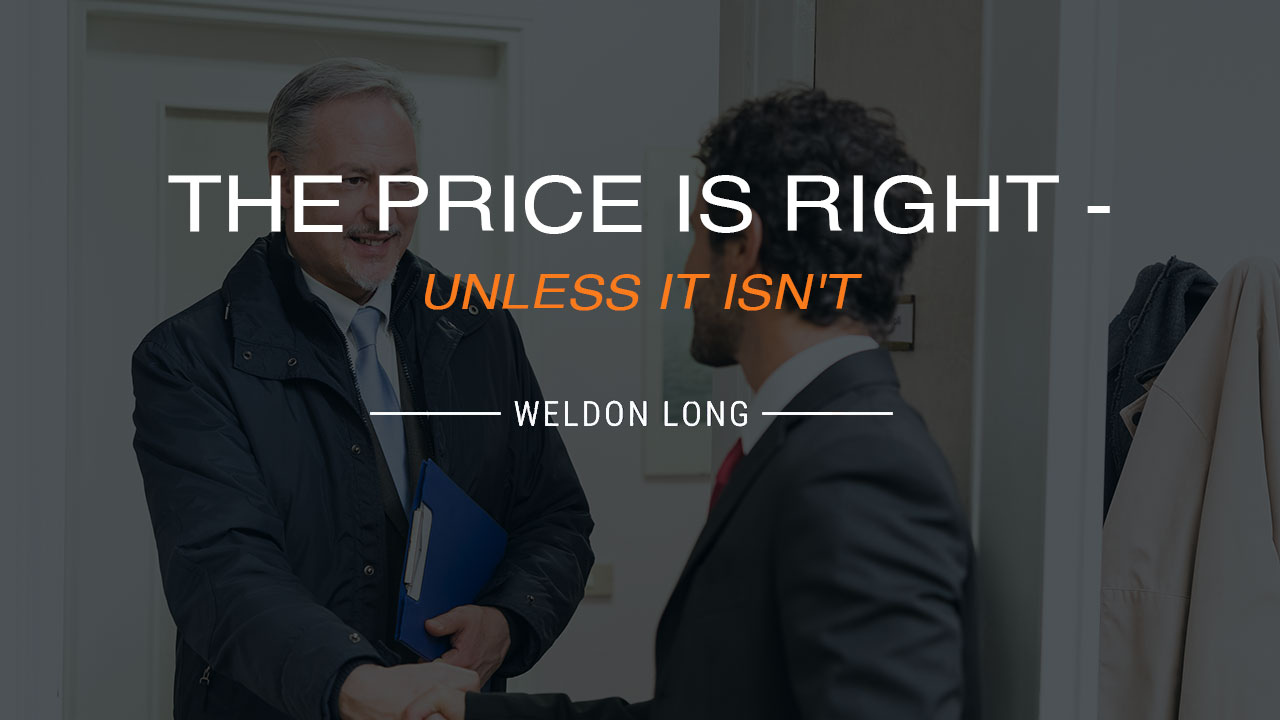The Price Is Right – Unless It Isn’t
July 6, 2023
You’re not going to close every sale, but… you do want to bring each sale to a conclusion. Now we hope the conclusion will end with you closing the deal, but regardless of the outcome, it must come to a close. And they’re either buying it from you, buying from a competitor or not buying at all.
Your job in this is to simply follow the sales process you’ve learned in training. The deals are going to come if you focus on the process because it involves doing everything you can to make the prospect more likely to buy from you than anyone else.
The Hive Mind
We need to understand that when the homeowner (or the prospect of any type) first sees your price, the same thought rings between their ears each time. And I’ll bet you’re already ahead of me, because it’s the universal response. The first thing that people think when they see your price is this – “How can I get it cheaper?” This may mean “How can I talk down your final price?” or “WHERE ELSE can I shop to get a better price than what you’re offering?”
Think about how you are as a consumer.
If you set out to make a large purchase, a boat for instance, and you see the price tag, what’s the first thing you start thinking about? “Wow, I hope I can get this cheaper.” It’s just human nature to think this. A penny saved is a penny earned.
So it’s our job to change that mentality when it comes to our prospective buyers. We don’t want them mentally shopping elsewhere before our presentation is even over. We want their full attention and we want them to make their purchase with us, end of story.
Rainy Day Fund
But before we can do that, we also need to understand the OTHER thought in a buyer’s mind, which is this: “Maybe I don’t need this product/service after all. If I don’t spend the money, I get to keep it all to myself.”
So now we’re also competing with the miserly, those who would rather save their funds for some future unknown purchase. So they see your price and they immediately compare it to ZERO. If they don’t buy your product, they spend zero dollars and they feel no separation anxiety when their money separates itself from their bank or wallet.
So there’s always this balance going on. “Do I, as the buyer, take my money and give it to you for your solution? Or do I pay someone else? Or do I keep it?” The game of psychological tennis has already begun.
Here’s one tip that has worked for me (and for many others). You’ll notice it in all types of sales environments.
Start with a very high price with your first system recommendation.
Why?
One reason is that after the initial sticker shock wears off, the prospect knows that you have no system that costs more than this, and they feel some of the pressure released. They know that there are several more systems on your price card and one will fall into their budget range as the conversation continues. And now instead of them focusing on spending ZERO, their focus becomes finding systems that are more affordable than the expensive option you first mentioned.
Mercedes Bends, Buyers Break
Many years ago, if you were going to buy a new Mercedes Benz, the Mercedes salesperson would first qualify you financially by running some numbers. Let’s say for the sake of argument that their salesperson qualified you for a budget of $50,000 for a new Mercedes.
The next thing he would do would be to show you cars 20 to 30 percent higher than your qualified budget. The reason for that is very simple. They’ve been around long enough to know your budget is probably going to grow. It happens all the time and they know it. You spend more money than you expect to spend because each upgrade looks and sounds appealing.
Instead of showing you cars within your budget, they will walk you past the $100,000 convertible on the showroom floor.
Why do they want to do that? Well, they want you to see it. They want you to feel it. They want you to look at the price tag. They want you to ask questions about this car.
And now suddenly when they take you outside to see the $75,000 cars, it doesn’t seem like such a big deal because you’re no longer comparing your budget to zero. Instead, you’re thinking that you’re saving $25,000 if you purchase the $75,000 car instead of the $100,000 convertible.
So it’s a very important part of the process, making sure your first discussed price is high if you plan on closing them a bit lower. So stop and think about that in the context of how you go about selling.
It’s not as effective to start with a low price and believe you’re going to upsell them into a better system. The math doesn’t show that to be the case very often.
What you want to do is to hit them with a high number because eventually there’s going to be some negotiation. And that doesn’t mean you’re going to drop your price or cut your margins. It means you’re going to show them a less expensive solution overall and make them feel like they are getting the best deal.


